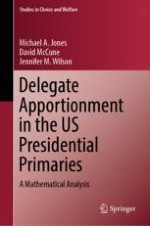2023 | OriginalPaper | Chapter
5. Properties of the Apportionment Methods Used in the Primaries
Authors : Michael A. Jones, David McCune, Jennifer M. Wilson
Published in: Delegate Apportionment in the US Presidential Primaries
Publisher: Springer International Publishing
Activate our intelligent search to find suitable subject content or patents.
Select sections of text to find matching patents with Artificial Intelligence. powered by
Select sections of text to find additional relevant content using AI-assisted search. powered by
